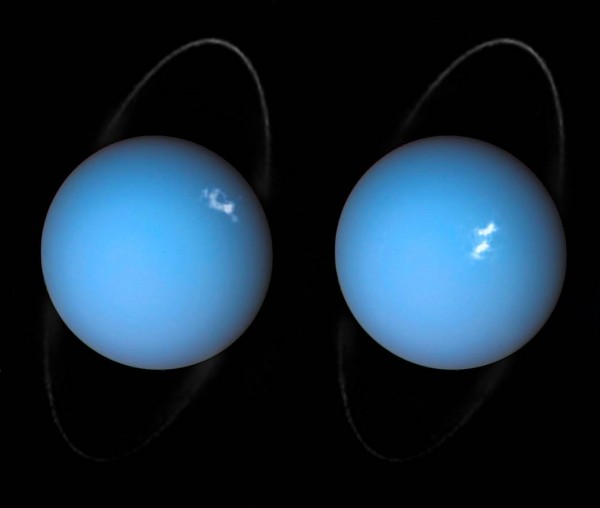By Ana Verayo, | April 11, 2017

This is a composite image of Uranus by Voyager 2 and two different observations made by Hubble — one for the ring and one for the auroras.
NASA just released two new images of Uranus revealing that this mysterious, gas giant is not only a swirling ball of thick, blue green gases. The Hubble Space Telescope also revealed rare and bright auroras lighting up the planet's atmosphere.
Prior to observations by the Hubble Space Telescope, the first space probe to obtain images of the gas world is NASA's Voyager 2 spacecraft which completed this flyby in 1986 after touring all the planets in the outer solar system. Its twin probe, Voyager 1, focused on Jupiter and Saturn and their moons.
Like Us on Facebook
The auroras on Uranus are similar to the Northern and Southern Lights seen on Earth and are also driven by the same atmospheric conditions. According to mission scientists from NASA and the European Agency, these auroras are caused by streaming charged particles similar to electrons that are coming from solar winds, its ionosphere and moon volcanism.
Auroras occur when these charged particles are swept by powerful magnetic fields and become concentrated on the upper atmosphere. These particles release bursts of light energy when they interact with other gas particles in the atmosphere such as oxygen and nitrogen. The last time that Uranus was caught by Hubble displaying its dazzling auroras was back in November 2011.
These newest images of Uranus also reveals its ring system that are found around its polar regions. These rings are originally found surrounding its equatorial region similar to Saturn, however since Uranus orbits the sun from its side, this means that its axis is directly pointed towards the sun. Astronomers suggest that the gas giant collided into an Earth sized planet that threw Uranus off its original axis.
After Jupiter and Saturn, Uranus is the third largest planet in our solar system that possesses a diameter four times wider than Earth's. Uranus also takes 84 years to complete a single orbit around the sun.
-
Use of Coronavirus Pandemic Drones Raises Privacy Concerns: Drones Spread Fear, Local Officials Say

-
Coronavirus Hampers The Delivery Of Lockheed Martin F-35 Stealth Fighters For 2020

-
Instagram Speeds Up Plans to Add Account Memorialization Feature Due to COVID-19 Deaths

-
NASA: Perseverance Plans to Bring 'Mars Rock' to Earth in 2031

-
600 Dead And 3,000 In The Hospital as Iranians Believed Drinking High-Concentrations of Alcohol Can Cure The Coronavirus

-
600 Dead And 3,000 In The Hospital as Iranians Believed Drinking High-Concentrations of Alcohol Can Cure The Coronavirus

-
COVID-19: Doctors, Nurses Use Virtual Reality to Learn New Skills in Treating Coronavirus Patients







